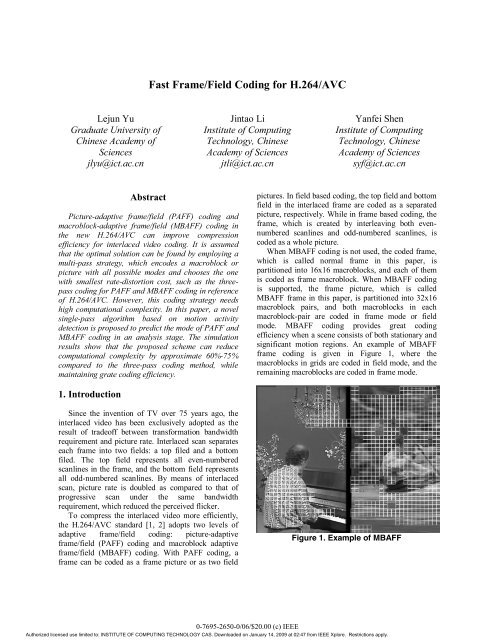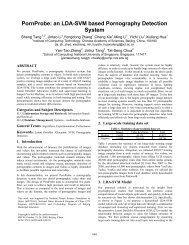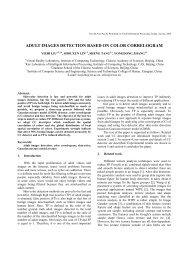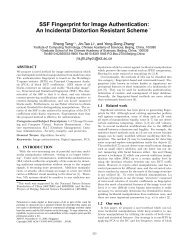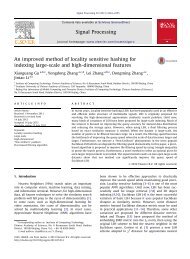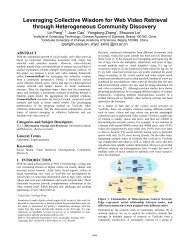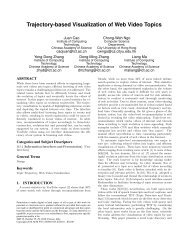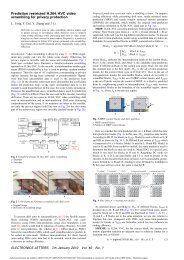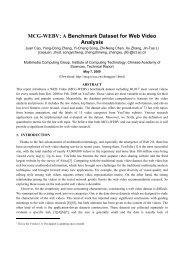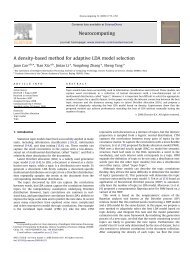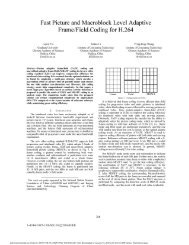Fast Frame/Field Coding for H.264/AVC
Fast Frame/Field Coding for H.264/AVC
Fast Frame/Field Coding for H.264/AVC
You also want an ePaper? Increase the reach of your titles
YUMPU automatically turns print PDFs into web optimized ePapers that Google loves.
Lejun Yu<br />
Graduate University of<br />
Chinese Academy of<br />
Sciences<br />
jlyu@ict.ac.cn<br />
<strong>Fast</strong> <strong>Frame</strong>/<strong>Field</strong> <strong>Coding</strong> <strong>for</strong> <strong>H.264</strong>/<strong>AVC</strong><br />
Abstract<br />
Picture-adaptive frame/field (PAFF) coding and<br />
macroblock-adaptive frame/field (MBAFF) coding in<br />
the new <strong>H.264</strong>/<strong>AVC</strong> can improve compression<br />
efficiency <strong>for</strong> interlaced video coding. It is assumed<br />
that the optimal solution can be found by employing a<br />
multi-pass strategy, which encodes a macroblock or<br />
picture with all possible modes and chooses the one<br />
with smallest rate-distortion cost, such as the threepass<br />
coding <strong>for</strong> PAFF and MBAFF coding in reference<br />
of <strong>H.264</strong>/<strong>AVC</strong>. However, this coding strategy needs<br />
high computational complexity. In this paper, a novel<br />
single-pass algorithm based on motion activity<br />
detection is proposed to predict the mode of PAFF and<br />
MBAFF coding in an analysis stage. The simulation<br />
results show that the proposed scheme can reduce<br />
computational complexity by approximate 60%-75%<br />
compared to the three-pass coding method, while<br />
maintaining grate coding efficiency.<br />
1. Introduction<br />
Since the invention of TV over 75 years ago, the<br />
interlaced video has been exclusively adopted as the<br />
result of tradeoff between trans<strong>for</strong>mation bandwidth<br />
requirement and picture rate. Interlaced scan separates<br />
each frame into two fields: a top filed and a bottom<br />
filed. The top field represents all even-numbered<br />
scanlines in the frame, and the bottom field represents<br />
all odd-numbered scanlines. By means of interlaced<br />
scan, picture rate is doubled as compared to that of<br />
progressive scan under the same bandwidth<br />
requirement, which reduced the perceived flicker.<br />
To compress the interlaced video more efficiently,<br />
the <strong>H.264</strong>/<strong>AVC</strong> standard [1, 2] adopts two levels of<br />
adaptive frame/field coding: picture-adaptive<br />
frame/field (PAFF) coding and macroblock adaptive<br />
frame/field (MBAFF) coding. With PAFF coding, a<br />
frame can be coded as a frame picture or as two field<br />
Jintao Li<br />
Institute of Computing<br />
Technology, Chinese<br />
Academy of Sciences<br />
jtli@ict.ac.cn<br />
Yanfei Shen<br />
Institute of Computing<br />
Technology, Chinese<br />
Academy of Sciences<br />
syf@ict.ac.cn<br />
pictures. In field based coding, the top field and bottom<br />
field in the interlaced frame are coded as a separated<br />
picture, respectively. While in frame based coding, the<br />
frame, which is created by interleaving both evennumbered<br />
scanlines and odd-numbered scanlines, is<br />
coded as a whole picture.<br />
When MBAFF coding is not used, the coded frame,<br />
which is called normal frame in this paper, is<br />
partitioned into 16x16 macroblocks, and each of them<br />
is coded as frame macroblock. When MBAFF coding<br />
is supported, the frame picture, which is called<br />
MBAFF frame in this paper, is partitioned into 32x16<br />
macroblock pairs, and both macroblocks in each<br />
macroblock-pair are coded in frame mode or field<br />
mode. MBAFF coding provides great coding<br />
efficiency when a scene consists of both stationary and<br />
significant motion regions. An example of MBAFF<br />
frame coding is given in Figure 1, where the<br />
macroblocks in grids are coded in field mode, and the<br />
remaining macroblocks are coded in frame mode.<br />
Figure 1. Example of MBAFF<br />
0-7695-2650-0/06/$20.00 (c) IEEE<br />
Authorized licensed use limited to: INSTITUTE OF COMPUTING TECHNOLOGY CAS. Downloaded on January 14, 2009 at 02:47 from IEEE Xplore. Restrictions apply.
The <strong>H.264</strong>/<strong>AVC</strong> standard does not allow the<br />
combination of normal frame and MBAFF frame<br />
coding in a bitstream with the same sequence header,<br />
but field and frame (normal frame or MBAFF frame)<br />
coding can be used together to improve the coding<br />
efficiency. This can be realized by per<strong>for</strong>ming an<br />
adaptive determination of the picture coding mode. In<br />
this paper, we focus on the combination of PAFF and<br />
MBAFF coding, because this combination can get the<br />
best coding efficiency. So the frame coding means<br />
MBAFF frame coding in the following text.<br />
Obviously, PAFF coding requires that an encoder<br />
has the ability to adaptively select the picture coding<br />
mode, and MBAFF requires that the encoder has the<br />
ability to adaptive select macroblock mode <strong>for</strong> each<br />
macroblock pair in a frame picture. In the <strong>H.264</strong>/<strong>AVC</strong><br />
reference software [5], a multi-pass approach is used to<br />
per<strong>for</strong>m the PAFF and MBAFF decisions. In this<br />
scheme, the frame is first encoded in frame picture<br />
mode. When MBAFF coding is used, every<br />
macroblock pair is coded as two frame macroblocks or<br />
two field macroblocks respectively, and the mode with<br />
lower rate-distortion cost is selected, and the<br />
corresponding bitrate-distortion cost of all the<br />
macroblock pairs in the frame are recorded and<br />
summed to get the cost of whole frame picture. It is<br />
obvious that this MBAFF frame coding strategy needs<br />
two-pass coding With PAFF coding, the same frame is<br />
also encoded in field mode, which means the frame is<br />
coded as two separate field pictures, and the ratedistortion<br />
cost of each macroblock is again recorded<br />
and summed to get the cost of two fields in the current<br />
frame. So three-pass coding is needed <strong>for</strong> PAFF and<br />
MBAFF coding in reference software [5]. Mode<br />
decision of PAFF coding is then made based on<br />
summed rate-distortion cost values obtained above.<br />
With the right rate-distortion optimization method,<br />
the mode selection scheme in reference software<br />
provides with an optimal decision <strong>for</strong> both MBAFF<br />
and PAFF coding, but the computational complexity<br />
triples compared to a single-pass approach, so less<br />
complicated MBAFF and PAFF coding are desirable.<br />
Based on the fact that field picture mode coding<br />
provides higher compression efficiency than frame<br />
picture mode coding <strong>for</strong> fast-moving scenes in<br />
interlaced video, and vice versa, some fast picture level<br />
frame/filed coding algorithms are proposed. A singlepass<br />
scheme [3] was previously proposed <strong>for</strong><br />
per<strong>for</strong>ming a picture level frame/field decision <strong>for</strong><br />
MPEG-2 video coding. Although the scheme is very<br />
effective <strong>for</strong> MPEG2, the method has never been tested<br />
<strong>for</strong> <strong>H.264</strong>/<strong>AVC</strong>. And a one pass PAFF coding scheme<br />
<strong>for</strong> <strong>H.264</strong>/<strong>AVC</strong> was proposed by Yin [4], which<br />
decides frame/field mode of picture by the motion<br />
activity of the whole frame. With the 2-field motion<br />
detection used by Yin, motion detection is not so<br />
accurate because of the different phase between the top<br />
field and bottom field in a frame. And MBAFF as a<br />
new tool <strong>for</strong> interlaced video coding in <strong>H.264</strong>, fast<br />
algorithm is not considered in all these papers<br />
available.<br />
As we known, very few papers have discussed the<br />
fast PAFF and MBAFF coding together. In this paper,<br />
a novel single-pass algorithm is proposed, which can<br />
simultaneously per<strong>for</strong>m both PAFF and MBAFF<br />
coding mode decisions <strong>for</strong> interlaced video based on<br />
the motion detection. A pre-analysis stage is per<strong>for</strong>med<br />
to decide the frame/field mode of each macroblockpair,<br />
and the PAFF coding mode is decided by all the<br />
macroblock-pair modes in the frame. The detailed<br />
algorithm is described in section 2, and simulation<br />
results and conclusions are given in section 3 and<br />
section 4 respectively.<br />
2. <strong>Fast</strong> PAFF and MBAFF coding<br />
Based on the posteriori result of using the RD based<br />
three-pass scheme, it can be confirmed that the PAFF<br />
and MBAFF coding modes are directly related to the<br />
motion activity within each scene or parts of scene.<br />
The frames or parts of a frame with high motion<br />
activity tend to prefer field coding, whereas frames<br />
characterized by low motion activity benefit from<br />
frame coding. To achieve fast frame/field coding, a<br />
simple and accurate motion detection algorithm is need<br />
<strong>for</strong> frame/field mode pre-decision at both picture and<br />
macroblock level. In this paper, we extend the 4-field<br />
motion detection algorithm used in de-interlacing<br />
technology [7].<br />
Let the pixel at ( x, y ) in current frame to be<br />
cxy ( , ) , whose corresponding pixel with the same<br />
position in the <strong>for</strong>ward frame is f ( xy , ) , so the<br />
motion status of pixel at ( x, y ) is defined as<br />
�1<br />
if | c( x, y) − f ( x, y) | > T1<br />
pxy ( , ) = � (1)<br />
�0<br />
otherwise<br />
where T 1 is a predefined threshold, and operator |·|<br />
denotes to calculate the absolute value. If the<br />
difference between cxy ( , ) and f ( xy , ) is larger than<br />
T 1 , then the motion status p( xy , ) equals to 1, which<br />
means the current pixel is in a moving region.<br />
Otherwise, cxy ( , ) is in a static region.<br />
Set the i-th macroblock pair to be MBP i , and the<br />
motion activity of MBP i is defined as the number of<br />
moving pixels in it, that is to say,<br />
0-7695-2650-0/06/$20.00 (c) IEEE<br />
Authorized licensed use limited to: INSTITUTE OF COMPUTING TECHNOLOGY CAS. Downloaded on January 14, 2009 at 02:47 from IEEE Xplore. Restrictions apply.
m = � p( x, y)<br />
(2)<br />
i<br />
( x, y) ∈MBPi<br />
The motion detection of macroblock pair MBP i is<br />
achieved by compare m i with a predefined threshold<br />
T 2<br />
�1<br />
if ( mi ( x, y) > T2<br />
)<br />
Di<br />
= � (3)<br />
�0<br />
otherwise<br />
If i D equals to 1, then the macroblock pair MBP i is in<br />
a moving region, which should be coded in field mode<br />
when MBAFF is used. Otherwise, MBP i is in a static<br />
region and frame macroblock coding is favorable <strong>for</strong><br />
MBAFF coding.<br />
To predict the PAFF coding mode, global motion<br />
detection of the whole frame should be per<strong>for</strong>med,<br />
which can be realized based on the results of motion<br />
detection of macroblock pairs. With the motion<br />
detection results { 0 D , 1 D ,…, D N -1 } of all the<br />
macroblock pairs in the current frame, where N is the<br />
total number of macroblock pairs in the current frame,<br />
the motion activity of the current frame is defined as<br />
N −1<br />
m = � D<br />
(4)<br />
frm i<br />
i=<br />
0<br />
The frame/field coding mode of current frame is<br />
decided by comparing<br />
threshold T 3 ,<br />
m frm with the pre-defined<br />
�� 1 if ( m frm < T3<br />
)<br />
Dfrm<br />
= �<br />
�� 0 otherwise<br />
(5)<br />
If D frm equals to 1, there is global motion in current<br />
frame, and field coding mode should be chosen <strong>for</strong><br />
PAFF coding, that is to say, the top and bottom fields<br />
are coded separately. If D frm equals to 0, most regions<br />
of current frame are static, and frame mode should be<br />
chosen <strong>for</strong> PAFF. When MBAFF is used, the<br />
macroblock level frame/field coding mode of each<br />
macroblock-pair MBP i is decided by the motion<br />
decision result D i , which has been discussed above.<br />
To sum up, with the motion detection algorithm<br />
introduced above, the PAFF and MBAFF coding can<br />
be achieved with only single-pass, the block diagram<br />
of which is illustrated in Figure 2. The motion<br />
detection results of MBAFF are transferred to frame<br />
picture coding module to control the coding mode of<br />
macroblock pairs. And the motion detection results of<br />
PAFF control the switch between field picture coding<br />
module and frame picture coding module.<br />
3. Simulation results<br />
Figure 2. Single-pass encoder with PAFF and<br />
MBAFF coding<br />
The proposed fast frame/field coding was<br />
integrated within the <strong>H.264</strong> reference software JM8.0<br />
[5]. The sequences in Table 1, Football, Boat,<br />
Musician are 720x576 interlaced videos at 50 fields per<br />
second. The sequences Football and Boat are fast<br />
motion sequences, while Musician with just lower<br />
motion of zoom. To get one sequence with both fast<br />
moving regions and static regions, the sequence<br />
Musiboat is combined of the left part of sequence of<br />
Boat and the right part of Musician. Only the first<br />
frame was coded as intra frame composed of two field<br />
pictures, and all the remaining pictures are coded as B<br />
or P frames in the pattern like BBPBBP…. With the<br />
main profile, quantization values 24, 28, 36 and 40<br />
were test. Per<strong>for</strong>mance of the proposed scheme was<br />
compared with the rate-distortion based three-pass<br />
decision in reference software JM8.0.<br />
The simulation results are shown in Table 1. The<br />
per<strong>for</strong>mance is compared with the PAFF+MBAFF<br />
coding, PAFF coding and MBAFF coding, and the<br />
corresponding results are shown in rows labeled as (1),<br />
(2) and (3) respectively. The peak signal noise ratio<br />
gain (�PSNR) and percentage of bitrate saving<br />
(�bitrate) are obtained by [6]. The percent of the time<br />
saving (Speedup), calculated with<br />
�t� − 1 × 100%<br />
proposed<br />
� t �<br />
� () i �<br />
proposed fast algorithm, () i<br />
( t proposed is the running time of<br />
t , i=1,2,3, is the running<br />
time of PAFF+MBAFF, PAFF, MBAFF respectively.),<br />
is used to evaluate the computational complexity.<br />
Because the fast motion in them, sequences<br />
Football and Boat can get better coding efficiency by<br />
PAFF coding than by MBAFF coding. And the<br />
0-7695-2650-0/06/$20.00 (c) IEEE<br />
Authorized licensed use limited to: INSTITUTE OF COMPUTING TECHNOLOGY CAS. Downloaded on January 14, 2009 at 02:47 from IEEE Xplore. Restrictions apply.
sequences of Musician and Musiboat benefit from<br />
MBAFF coding because of large static regions in them.<br />
These means only PAFF coding or only MBAFF can<br />
not get the best compression efficiency. The simulation<br />
result show that, <strong>for</strong> all the tested sequence,<br />
PAFF+MBAFF coding is the best one of all the coding<br />
schemes Compared with all the PAFF+MBAFF, the<br />
proposed single-pass coding algorithm reduce about<br />
60%-75% computational complexity, with the cost of<br />
0.06-0.21dB PSNR decrease or 1.34%-3.96% bitrate<br />
increase.<br />
Compared with PAFF coding or MBAFF coding,<br />
the proposed single-pass frame/field coding is more<br />
efficient when all the test sequences are considered,<br />
and computational complexity is reduced about 30% to<br />
Table 1. Per<strong>for</strong>mance of the proposed scheme<br />
Sequences<br />
�bitrate<br />
(%)<br />
�PSNR<br />
(dB)<br />
Speedup<br />
(%)<br />
(1) +3.96 -0.21 -63.25<br />
Football (2) +1.59 -0.09 -34.48<br />
(3) -6.26 +0.34 -51.04<br />
(1) +4.41 -0.27 -62.09<br />
Boat (2) +2.83 -0.18 -33.88<br />
(3) -10.60 +0.69 -44.95<br />
(1) +1.34 -0.06 -74.18<br />
Musician (2) -3.36 +0.16 -55.35<br />
(3) +2.54 -0.11 -62.13<br />
(1) +3.45 -0.19 -68.65<br />
Musiboat (2) -1.94 +0.11 -45.48<br />
(3) +4.41 -0.24 -53.47<br />
Note: data in the rows labeled as (1), (2), (3) are results compared<br />
with PAFF+MBAFF coding, PAFF coding and MBAFF coding<br />
respectively<br />
PSNR(dB)<br />
38<br />
37<br />
36<br />
35<br />
34<br />
33<br />
32<br />
31<br />
30<br />
29<br />
28<br />
Musiboat<br />
Proposed<br />
PAFF+MBAFF<br />
PAFF<br />
MBAFF<br />
<strong>Frame</strong><br />
<strong>Field</strong><br />
1000 2000 3000 4000 5000 6000 7000 8000 9000 10000<br />
bit-rate(kbps)<br />
Figure 3. Rate-distortion per<strong>for</strong>mance<br />
60% respectively. To show the compression efficiency<br />
more obviously, the rate-distortion per<strong>for</strong>mance <strong>for</strong><br />
sequence Musiboat is illustrated in Figure 3, where<br />
normal frame coding (“<strong>Frame</strong>”) and field (“<strong>Field</strong>”) are<br />
also provided. We can tell the proposed algorithm can<br />
maintain great coding efficiency.<br />
4. Conclusions<br />
A novel fast frame/field algorithm is proposed in<br />
this paper, in which both PAFF and MBAFF modes are<br />
decided with motion detection in the pre-analysis<br />
stage. The proposed single-pass frame/filed coding<br />
scheme can reduce computational complexity by about<br />
60%-75% as compared with the three-pass method in<br />
reference software of <strong>H.264</strong>/<strong>AVC</strong>, while great coding<br />
efficiency is maintained.<br />
5. Acknowledgements<br />
This work was supported in part by the National<br />
Nature Science Foundation of China (60473002), the<br />
Key Project of Beijing Natural Science Foundation<br />
(4051004) and the Key Project of International Science<br />
and Technology Cooperation (2005DFA11060).<br />
6. References<br />
[1] T. Wiegand, G.J. Sullivan, G. Bjontegaard and A. Luthra,<br />
“Overview of the <strong>H.264</strong>/<strong>AVC</strong> Video <strong>Coding</strong> Strandard,”<br />
IEEE Transactions on Circuits and Systems <strong>for</strong> Video<br />
Tecnology, vol.13, no.7, July 2003, pp. 560-576.<br />
[2] “Advanced video coding <strong>for</strong> generic audiovisual<br />
services,” ITU-T Recommendation <strong>H.264</strong>, May. 2005.<br />
[3] X.M. Zhang, A. Vetro and H. Sun, “Adaptive field/frame<br />
selection <strong>for</strong> high compression coding,” Proceedings of the<br />
2003 SPIE Conf. on Image and Video Communications and<br />
Processing, vol.5022, Jan 2003, pp.583-593.<br />
[4] P. Yin, A.M. Tourapis, J. Boyce, “<strong>Fast</strong> decision on<br />
picture adaptive frame/field coding <strong>for</strong> <strong>H.264</strong>,” Visual<br />
Communications and Image Processing 2005, SPIE,<br />
Bellingham, 2005, pp. 2092-2099.<br />
[5] JVT Reference Software version JM8.0,<br />
http://bs.hhi.de/~suehring/tml/download<br />
[6] G.Bjontegaard, “Calculation of average PSNR differences<br />
between RD-Curves”, VCEG-M33, Mar. 2001.<br />
[7] C. Lee, S. Chang and C. Jen, “Motion adaptive pro-scan<br />
conversion,” IEEE Internal Symposium on Circuits and<br />
Systems, 1991, Pages :666-669.<br />
0-7695-2650-0/06/$20.00 (c) IEEE<br />
Authorized licensed use limited to: INSTITUTE OF COMPUTING TECHNOLOGY CAS. Downloaded on January 14, 2009 at 02:47 from IEEE Xplore. Restrictions apply.


